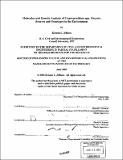Molecular and genetic analysis of Cryptosporidium spp. oocysts : sources and genotypes in the environment
Author(s)
Jellison, Kristen L. (Kristen Leigh), 1975-
DownloadFull printable version (12.37Mb)
Other Contributors
Massachusetts Institute of Technology. Dept. of Civil and Environmental Engineering.
Advisor
Harold F. Hemond and David B. Schauer.
Terms of use
Metadata
Show full item recordAbstract
Cryptosporidium parvum is responsible for an acute gastrointestinal disease that is self-limiting in immunocompetent people but potentially life-threatening for the immunocompromised. Until recently, C. parvum was the only species of Cryptosporidium known to cause disease in people, however, reports of C. muris, C. felis, and C. meleagridis in immunocompetent adults have raised questions about the extent to which Cryptosporidium spp. are infectious for humans. Until more is known, presence of any Cryptosporidium oocysts in the environment should be considered a potential public health risk. Cryptosporidium spp. can infect a wide range of animal hosts, and environmental sources may include wildlife, agricultural animals, or human sewage. Transmission of Cryptosporidium spp. via fecally-contaminated food and water has been well-documented, and outbreaks of cryptosporidiosis have occurred around the world. The exogenous stage of the organism, the oocyst, is difficult to remove from drinking water supplies because it is resistant to chlorine disinfection and inefficiently filtered. Therefore, a better understanding of the sources, fate, and transport of oocysts in the environment is critical to protect source waters from oocyst contamination. In this work, a sensitive and specific molecular detection assay for Cryptosporidium spp. in environmental samples was developed and applied to surface water and fecal samples from the Wachusett Reservoir watershed, the drinking water source for metropolitan Boston, to establish links between oocyst sources and surface water contamination. Multiple species of Cryptosporidium were detected, and previously uncharacterized genetic diversity at the 18S rRNA locus was observed. (cont.) Each surface water site had a hypothesized oocyst source, but results showed that the sources detected were often very different from those hypothesized to be most important. Cryptosporidium spp. from wildlife was detected in surface waters hypothesized to be contaminated by human sewage, and surface waters susceptible to agricultural runoff were observed to be more impacted by birds. In addition, Cryptosporidium spp. contamination occurred seasonally, with the seasonal pattern of detection distinct for surface waters with different oocyst sources. Results of this work contribute to a growing characterization of Cryptosporidium in the environment that will ultimately help minimize public exposure to this waterborne parasite.
Description
Thesis (Ph. D.)--Massachusetts Institute of Technology, Dept. of Civil and Environmental Engineering, 2003. Includes bibliographical references.
Date issued
2003Department
Massachusetts Institute of Technology. Department of Civil and Environmental EngineeringPublisher
Massachusetts Institute of Technology
Keywords
Civil and Environmental Engineering.